Canadian Badlands Passion Play
The Canadian Badlands Passion Play is a theatrical production based on the life, death, and resurrection of Jesus Christ performed annually since 1994 in Drumheller, Alberta, Canada. The play takes place every July in a natural bowl amphitheater found in the Drumheller Valley, less than 10 minutes from downtown. The unique outdoor location was chosen for the topographical similarity to the Israeli countryside surrounding Jerusalem, as well as the superb natural acoustics. It follows the story of the life, death and resurrection of Jesus found in the Gospels, told through drama and music, using over 200 volunteer performers and professional theatre crew. The script is rewritten often to tell the story from a fresh perspective. Each year, more than 10,000 audience members travel to Drumheller for the Badlands Passion Play, an area already known for tourist attractions like the Canadian Badlands and the Royal Tyrell Museum.
History
In 1988 the founder of the Rosebud Theatre and Rosebud School of the Arts, Laverne Erickson, formed a steering committee and began gaining the support of local community organizations for what would become the Canadian Badlands Passion Play. The charter meeting for the establishment of a passion play was held in 1990, and thus was born the Canadian Badlands Passion Play Society. The Honourable Gordon Taylor, Former Minister of Highways for Alberta and Member of the Legislative Assembly for the Drumheller Riding, was presented with the title of honorary chairman for the society. During the 1960s, Mr. Taylor had put forth efforts in Drumheller to produce a passion play for the area, but the project was never started due to several factors.
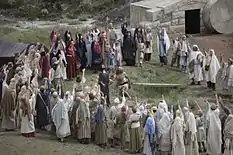
The society set Summer 1994 as its goal for the first production of the show. 30 acres (120,000 m2) of land were obtained, in addition to another 65 acres (260,000 m2) owned in conjunction with the Drumheller Valley Ski Hill. In July of that year, the Canadian Badlands Passion Play held its premiere performance, filling the 1150 available seats. The original playwright, Kathy Covert, directed the show.
The next years saw the introduction of many changes and upgrades, including an increase in seating, the building of a choir loft, expansion of the set, and various script changes. Regional choir rehearsals occurred throughout Alberta and Saskatchewan. 1998 saw the Society's first Winter Choir Concert Series in Lethbridge, Calgary, and Red Deer.
In the year 2001, the Jerusalem Wall Project opened its first phase. The project meant to replicate on a smaller scale the actual Jerusalem Wall in Israel. The Jerusalem Wall through the years has housed many services including a black box theatre and interpretive museum, but is currently home to a concession, gift shop, wardrobe, armoury, production offices, and a rehearsal space. 2003 introduced a variety of small scale dramatic performances on the site, although this initiative lasted only three years.
In 2006, partly in response to declining ticket sales, the production was completely updated with a new script based on the Gospel According to Matthew, by Royal Sproule, and new music by Bill Hamm. Auditions were held province-wide, the musical instrumentation was expanded, and a character was added as a narrator to help the audience follow changes of time and location in the storyline.
2011 marked the 20th anniversary of the founding of the Passion Play and its 100th performance on the outdoor stage. It was commemorated with a heritage coffee table book with photographs that focus on the past five years of performances. Playwright Royal Sproule wrote a new script that focused on retelling the life of Christ through the eyes of the Apostle John. The choir moved from the Choir Loft to joining the actors on stage, and the play ran for seven nights instead of six. The Passion Play also debuted a new sound reinforcement system for its 2011 performances. This three-dimensional sound system enhances the audiences' audio experience, and strategically places sound (both voice and music) to keep the audience engaged as the visual action unfolds in front them. This modification not only assists those who have difficulty hearing, but also allows the entire audience to feel more like they are a part of the action. In 2011 the Passion Play was also the subject of an award-winning documentary by Philip Spink and Zuzana Novak.
In 2013, the Passion Play was awarded the Alto "Pride of Alberta" award from Alberta Tourism.
In 2014, the American Bus Association named the Canadian Badlands Passion Play one of the top 100 events in North America.
In 2015, the Chambers of Conference of Alberta presented the Passion Play with the Award of Distinction in Arts and Culture. Other awards included the 2015 Alberta Tourism Marketing Award, and the 2015 Alberta Tourism Collaborative Marketing Award.
In 2016, a new script was adapted from the Gospel of Luke by Barrett Hileman, and directed by Brian Jensen.
The Society Mandate
The purpose of the Canadian Badlands Passion Play is to:
1. Portray the life of Jesus
2. Increase awareness and skill in the arts
3. Unify our community around common projects and encourage tourism by creating significant cultural attractions
Tag-lines for the Passion Play have included "An authentic experience with the life of Jesus Christ", "The Greatest Story Ever Told", and "An epic story of Faith, Hope, and Love".
The Performance
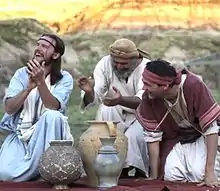
Although the details of the script often change from year to year, the story usually spans 3 hours and is not limited to portraying only the final hours of Christ (the traditional "Passion of the Christ"). Unlike many Passion Plays around the world, the Badlands Passion Play also dramatizes the life, ministry, and resurrection of Jesus. Action occurs on every viewable space, including the set, the hills, and the audience area. The performance occurs in nearly any weather, with the exception of weather that threatens the safety of viewers or performers.
Music
Musical underscoring is a powerful element of the show. The play is infused with choral and instrumental music, as well as onstage singing and playing by cast members. The original choir pulled from English and Hebrew religious texts, as well as providing a dramatic vocalise style underscoring some scenes on stage. From 2006 to 2011, the music was written by Bill Hamm, a professor at Rosebud School of the Arts, and central figure in the Rosebud Theatre. This music shifted away from the chorale style and single electric keyboard of the prior script, and expanded to include trumpets, euphonium, tuba, timpani and other percussion, and other instruments. Portions of the music were drawn from Hebrew folksongs, and one piece in particular from Antonio Vivaldi's Gloria. Others were inspired by the Classical canon of composers, such as Mozart. Some of the music was based on modal textures, such as the Phrygian dominant scale (also known as Ahava Rabboh, Freygish, Hijaz maqam, or Jewish Scale) which is constructed by raising the third note of the Phrygian modal scale. In 2011, Luke Ertman became the composer and developed an epic score for the Gospel of John (2010–2015) and the Gospel of Luke (2016–present). This music plays much like a film score, heightening drama and enhancing the overall artistry.
Performers
The body of performers is drawn from a pool of musicians and actors from across Alberta, and in some cases reaching into Saskatchewan, British Columbia, and even Ontario. It is composed mainly of volunteer amateur actors and musicians, however also involves a few notable professionals, such as actors from Canadian Actor's Equity Association and ACTRA. Although the cast size fluctuates from year to year, the average number of performers each year is around 200 people of all ages.
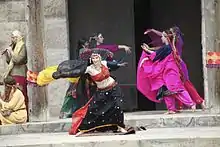
Wardrobe
Costumers in the Wardrobe department extensively research authentic first century garb in the Middle East. It was unlawful to have a graven image for the Jewish people of that time, and so there are little to no pictorial resources which can be drawn upon in the way of statues and engravings. Much of the wardrobe is therefore based upon text descriptions by historians, and the customs and culture of present-day Orthodox Jews. Much is also drawn from studying the wardrobe and culture of the Bedouins, who have changed relatively little over the centuries. Many performers have multiple roles, and therefore multiple costumers, demanding a vast archive of costume pieces.
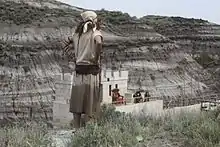
Nature's Special Effects
A large part of the draw of an outdoor theatrical experience is the surrounding nature. Shows have been highlighted by sunsets, eagles, seagulls, gophers, wind, light rain, and timely cloud breaks. Even windstorms and rainstorms are known to enhance the experience of viewers.
Narrator
With the introduction of the Matthew script in 2006, the convention of a Narrator was also added. A narrator gives the story a personal perspective, allowing the audience to see what the world may have been like through the eyes of one of a disciple or traditional writer of one of the gospel accounts. A narrator character also helps the audience follow changes in time and place. Previous narrators have included Matthew the Evangelist, John the Apostle, and Mary Magdalene.
Script Evolution
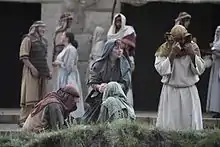
Original Script (1994-1996)
The original script used for the show was written by Kathy Covert, who also wrote a portion of the lyrics for the music. This script was used for two years.
Gospel of John by Randall Wiebe (1996-2005)
In 1996, Randall Wiebe wrote a new script, based primarily on the Gospel of John. New music and lyrics were written by the Society founder, Laverne Erickson. The script was used for another 11 years, with annual edits and updates in order to keep the show fresh. Scenes were added and deleted according to playwright and director tastes. Over time a marketplace developed, taking place behind the main action, from which characters could be drawn for certain scenes.
The Gospel According to Matthew (2006-2010)
In 2006, partly in response to declining ticket sales, as well as a desire for a fresher production, a new script was written by Royal Sproule (with excerpts taken with permission from Murray Watts' "Miracle Maker"), and music was written by Bill Hamm, both of whom are quite prominent in the Rosebud Theatre community. The new script saw a move away from the marketplace backdrop and other crowd-oriented scenes, in favour of developing individual relationships within the story. With such a large cast, the crowd almost functioned as its own character within the choreography of the show.
This revitalized script gave an increased artistic approach to the story. The concept was to employ theatrical techniques to make the story more powerful and engaging, while remaining true to the history of the story. Allusions were made to Shakespeare's Henry V, most significantly, the opening speech delivered by Matthew, which is derived largely from the Chorus' introduction. Several surrealistic and symbolic theatre techniques were employed. The script also deepened the humanity of the characters, particularly the disciples and female followers, and explored their relationships and interactions with one another.
The Gospel of John by Royal Sproule (2011-2015)
2011 launched a new, fast-paced, action-oriented telling of the Gospel of John. Rich with colour and pageantry, followers of Jesus wore blue that matched the sky above the Passion Play. Playwright and director, Royal Sproule, warned that while Matthew was an easy story to digest, John doesn't pull any punches. With noticeably more violence and an epic new score, this version of the Passion Play was cinematic in feel and scope.
Stage
The Passion Play stage is placed within a natural bowl amphitheatre in the hills of the Badlands known as the Badlands Amphitheatre. The space encompasses 2700 seats, as well as a 300-seat choir loft, although the recent addition of a musicians' platform has decreased this number slightly. The stage itself has undergone massive upgrades over the years. It currently holds a large set building that serves both as a backstage and as a prop storage during the off-season. A large cement paddock is at the front of the building marking areas known as the "temple" and the "marketplace". . Some aspects of the stage were used during the 11-year run of the old script, before the 2006 change, largely as part of the marketplace backdrop. After the script change was made and the marketplace was no longer used as such, staging no longer required some of these stage areas, and they become largely a part of the atmosphere of the play, rather than a part of the show directly. The front of the stage is marked by a large wooden dock, representing the coast of Lake Gennesaret (or the Sea of Galilee) and other bodies of water. Carved into one hill are stairs leading up to "Calvary", and at its base lie tombs which are used at various points in the production. in 2019, an orchestra house was added onto the right side of the stage. The entire area is used in the production, including the surrounding hillside.
The Summer Theatre Project
The Summer Theatre Project was an initiative started in 2003 to extend the Passion Play site as a summer-long cultural attraction. The project ran for 3 years and included family shows, contemporary productions, and solo performances based on biblical stories. In 2012, a small amphitheatre with 300 seats was completed on the Passion Play site. The Forum Theatre continues to be used by performers, musician, and community organizations.
Planned Advancements
Several upgrades are planned for the show and the production site. The remaining phases of the Jerusalem Wall Project (the first of which was completed in 2001), will see the renovation of the current phase, as well as an extension from the current wall to the set building allowing for transport of props, actors, and storage materials. Further improvements to an animal holding area used during the production run were completed to accommodate the live animals used in the show. Renovations to office spaces to increase efficiency and staff comfort. A Roman Road campaign has been launched, and will see the paving of a period style road designed for the ease of visitors, and actors during the show. Seating was expanded and in 2010 the website featured for the first time an online ticketing system where patrons can even choose the seat they'd like if booked early. Improvements and repairs were made to the set and set buildings as well. In 2011 the implementation of a $100,000 three dimensional surround sound system to enhance the audiences' audio experiences and accommodate those with difficulty hearing.
See also
References
DrumhellerMail.ca (13 June 2008). "The Passion Play - The Story behind the Story". The Weekender. Drumheller, AB, Canada: Drumheller Mail. Retrieved 11 May 2009.
"The Canadian Badlands Passion Play Society 2008 Annual Report" (Press release). The Canadian Badlands Passion Play Society. January 2009.
Wiebe, Randall. "The Canadian Badlands Passion". Sandalstrap. Retrieved 11 May 2009.
"The Canadian Badlands Passion". canadianbadlandsPP. Retrieved 18 January 2011.